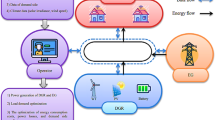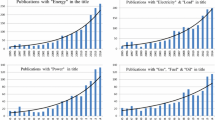Abstract
Demand forecasting and electricity trading are two major fields of study for power system operators. These two issues have not been integrated by scholars for analysing performance of power system operator. The main motivation behind this manuscript is to integrate load forecasting with energy trading. Emergence of robust infrastructure in decentralized energy trading among power system operators and development in recent trends in artificial intelligence techniques to forecast load has helped to rethink the strategies behind operation of power systems. In this manuscript, an objective for peer-to-peer (P2P) energy trading is designed in a distribution network with integrated short-term load forecasting (STLF). The solution for the designed objective is proposed using mid-market rate (MMR) method for P2P trading with stochastic integrated STLF. Stochastic methods used for STLF are tree, linear regression, support vector machine, ensemble, Gaussian process regression and neural network. After comparative analyses, the best method is found, i.e. tree, and it is further optimized using three optimization techniques, viz. grid search, random search and Bayesian optimization, with an objective of reducing mean square error (MSE) for hyperparameters tuning. Among the three optimization methods, grid search has a reduced MSE of 0.0066 and leaf size of 3. The hyperparameter-tuned STLF is used for P2P energy trading. The energy trading price is decided using MMR method, and it optimized the total energy cost. The whole algorithm is implemented in Python and MATLAB platforms. It is observed that total energy cost in P2P trading is reduced by 36.114% with STLF which validates the proposed algorithm.















Similar content being viewed by others
References
Vardhan BS, Khedkar M, Shahare K (2022) A comparative analysis of various stochastic approaches for short term load forecasting. Int Conf Adv Technol. https://doi.org/10.1109/ICONAT53423.2022.9725931
Kumar S, Mishra S, Gupta S (2016) Short term load forecasting using ANN and multiple linear regression. Second Int Conf Comput Intell Commun Technol. https://doi.org/10.1109/CICT.2016.44
Aprillia H, Yang HT, Huang CM (2012) Statistical load forecasting using optimal quantile regression random forest and risk assessment index. IEEE Trans Smart Grid 12(2):1467–80. https://doi.org/10.1109/TSG.2020.3034194
Vardhan BS, Khedkar M, Srivastava I (2021) Cost effective day-ahead scheduling with stochastic load and intermittency forecasting for distribution system considering distributed energy resources. Energy Sources, Part A: Recover Utilization Environ Eff. https://doi.org/10.1080/15567036.2021.1983669
Ding C, Bao TY, Huang HL (2021) Quantum-inspired support vector machine. IEEE Trans Neural Netw Learn Syst. https://doi.org/10.1109/TNNLS.2021.3084467
Xie Z, Wang R, Wu Z, Liu T (2019) Short-term power load forecasting model based on fuzzy neural network using improved decision tree. IEEE Sustain Power Energy Conf. https://doi.org/10.1109/iSPEC48194.2019.8975070
Ray PK, Mohanty SR, Kishor N, Catalao JP (2013) Optimal feature and decision tree-based classification of power quality disturbances in distributed generation systems. IEEE Trans Sustain Energy 5(1):200–8. https://doi.org/10.1109/TSTE.2013.2278865
Malekizadeh M, Karami H, Karimi M, Moshari A, Sanjari MJ (2020) Short-term load forecast using ensemble neuro-fuzzy model. Energy 196:117127. https://doi.org/10.1016/j.energy.2020.117127
Von Krannichfeldt L, Wang Y, Zufferey T, Hug G (2021) Online ensemble approach for probabilistic wind power forecasting. IEEE Trans Sustain Energy 13(2):1221–33. https://doi.org/10.1109/TSTE.2021.3124228
Nejati M, Amjady N (2021) A new solar power prediction method based on feature clustering and hybrid-classification-regression forecasting. IEEE Trans Sustain Energy 13(2):1188–98. https://doi.org/10.1109/TSTE.2021.3138592
Gan LK, Zhang P, Lee J, Osborne MA, Howey DA (2020) Data-driven energy management system with Gaussian process forecasting and MPC for interconnected microgrids. IEEE Trans Sustain Energy 12(1):695–704. https://doi.org/10.1109/TSTE.2020.3017224
Hosein S, Hosein P (2017) Load forecasting using deep neural networks. IEEE Power Energy Soc Innov Smart Grid Technol Conf. https://doi.org/10.1109/ISGT.2017.8085971
Yu T, Zhu H (2020) Hyper-parameter optimization: a review of algorithms and applications. arXiv preprint arXiv:2003.05689. https://doi.org/10.17632/n99dryms76.1
Jadhav AM, Patne NR (2017) Priority-based energy scheduling in a smart distributed network with multiple microgrids. IEEE Trans Ind Inf 13(6):3134–43. https://doi.org/10.1109/TII.2017.2671923
Jogunola O, Adebisi B, Anoh K, Ikpehai A, Hammoudeh M, Harris G (2021) Multi-commodity optimization of peer-to-peer energy trading resources in smart grid. J Mod Power Syst Clean Energy 10(1):29–39. https://doi.org/10.35833/MPCE.2020.000136
Khorasany M, Mishra Y, Babaki B, Ledwich G (2019) Enhancing scalability of peer-to-peer energy markets using adaptive segmentation method. J Mod Power Syst Clean Energy 7(4):791–801. https://doi.org/10.1007/s40565-019-0510-0
Abeygunawardana A, Liu A, Ledwich G (2021) A grid-friendly neighborhood energy trading mechanism. J Mod Power Syst Clean Energy. https://doi.org/10.35833/MPCE.2020.000925
Si F, Han Y, Xu Q, Wang J, Zhao Q (2022) Cloud-edge-based we-market: autonomous bidding and peer-to-peer energy sharing among prosumers. J Mod Power Syst Clean Energy. https://doi.org/10.35833/MPCE.2021.000602
Chen L, Xu Q, Yang Y, Gao H, Xiong W (2022) Community integrated energy system trading: a comprehensive review. J Mod Power Syst Clean Energy. https://doi.org/10.35833/MPCE.2022.000044
Akter MN, Mahmud MA, Oo AM (2016) A hierarchical transactive energy management system for microgrids. In: 2016 IEEE power and energy society general meeting (PESGM), pp 1–5. https://doi.org/10.1109/PESGM.2016.7741099
Amin W, Huang Q, Umer K, Zhang Z, Afzal M, Khan AA, Ahmed SA (2020) A motivational game-theoretic approach for peer-to-peer energy trading in islanded and grid-connected microgrid. Int J Electr Power Energy Syst 123:106307. https://doi.org/10.1016/j.ijepes.2020.106307
Long C, Wu J, Zhang C, Thomas L, Cheng M, Jenkins N (2017) Peer-to-peer energy trading in a community microgrid. In: 2017 IEEE power and energy society general meeting, pp 1–5. https://doi.org/10.1109/PESGM.2017.8274546
Zhou Y, Wu J, Long C (2018) Evaluation of peer-to-peer energy sharing mechanisms based on a multiagent simulation framework. Appl Energy 222:993–1022
Cherala V, Yemula PK (2020) Peer-to-peer energy sharing model for interconnected home microgrids. In: International conference on power systems technology (POWERCON), pp 1–6
Zhang C, Wu J, Cheng M, Zhou Y, Long C (2016) A bidding system for peer-to-peer energy trading in a grid-connected microgrid. Energy Proc 103:147–52. https://doi.org/10.1016/j.egypro.2016.11.264
Murkin J, Chitchyan R, Ferguson D (2018) Goal-based automation of peer-to-peer electricity trading. In: InFrom science to society, pp 139–151
Zhou Y, Wu J, Long C, Cheng M, Zhang C (2017) Performance evaluation of peer-to-peer energy sharing models. Energy Proc 143:817–22. https://doi.org/10.1016/j.egypro.2017.12.768
Liu N, Wang J, Yu X, Ma L (2018) Hybrid energy sharing for smart building cluster with CHP system and PV prosumers: a coalitional game approach. IEEE Access 6:34098–108. https://doi.org/10.1109/ACCESS.2018.2847023
Li J, Ye Y, Strbac G (2020) Stabilizing peer-to-peer energy trading in prosumer coalition through computational efficient pricing. Electr Power Syst Res 189:106764. https://doi.org/10.1016/j.epsr.2020.106764
Gungor VC, Sahin D, Kocak T, Ergut S, Buccella C, Cecati C, Hancke GP (2011) Smart grid technologies: communication technologies and standards. IEEE Trans Ind Inf 7(4):529–39. https://doi.org/10.1109/TII.2011.2166794
Sauter T, Lobashov M (2010) End-to-end communication architecture for smart grids. IEEE Trans Ind Electron 58(4):1218–28. https://doi.org/10.1109/TIE.2010.2070771
Paudel A, Beng GH (2018) A hierarchical peer-to-peer energy trading in community microgrid distribution systems. In: 2018 IEEE power and energy society general meeting (PESGM) 2018; pp 1-5. https://doi.org/10.1109/PESGM.2018.8586168
Hussain M, Mashitah (2020) Load data in Malaysia. [Online]. https://dx.doi.org/10.21227/67vy-bs34. https://doi.org/10.17632/n99dryms76.1
Author information
Authors and Affiliations
Contributions
ADM and BVSV were involved in conceptualization, methodology, writing—review and editing and writing—original draft preparation; ADM, NRP and BVSV were involved in formal analysis and investigation; and NRP and MK were involved in supervision
Corresponding author
Ethics declarations
Conflict of interest
The authors declare that they have no competing interests as defined by Springer, or other interests that might be perceived to influence the results and/or discussion reported in this paper.
Ethical approval
Not applicable.
Additional information
Publisher's Note
Springer Nature remains neutral with regard to jurisdictional claims in published maps and institutional affiliations.
Rights and permissions
Springer Nature or its licensor (e.g. a society or other partner) holds exclusive rights to this article under a publishing agreement with the author(s) or other rightsholder(s); author self-archiving of the accepted manuscript version of this article is solely governed by the terms of such publishing agreement and applicable law.
About this article
Cite this article
Manchalwar, A.D., Patne, N.R., Vardhan, B.V.S. et al. Peer-to-peer energy trading in a distribution network considering the impact of short-term load forecasting. Electr Eng 105, 2069–2081 (2023). https://doi.org/10.1007/s00202-023-01793-8
Received:
Accepted:
Published:
Issue Date:
DOI: https://doi.org/10.1007/s00202-023-01793-8




